Bennemann K.H., Ketterson J.B. Superconductivity: Volume 1: Conventional and Unconventional Superconductors; Volume 2: Novel Superconductors
Подождите немного. Документ загружается.

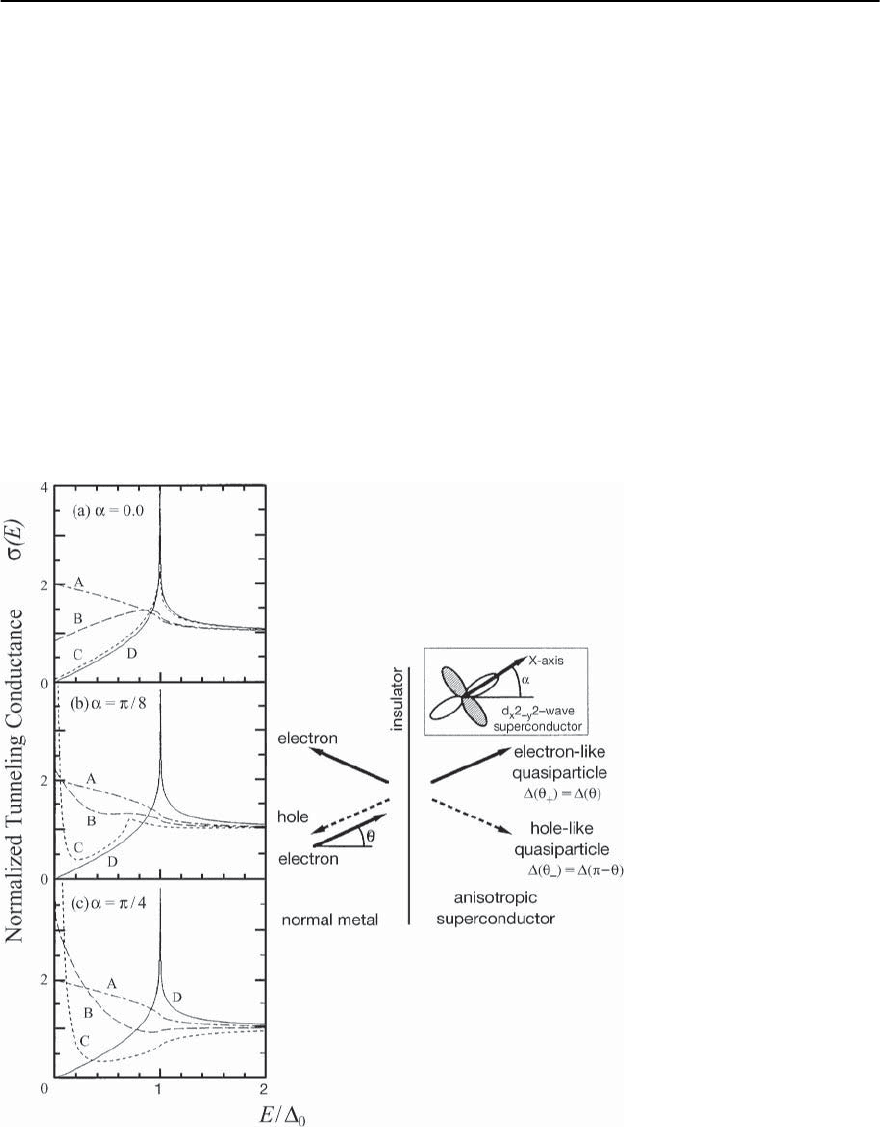
838 J.Zasadzinski
though only half of the series resistance for quasipar-
ticle excitations is present, and thus the conductance
is doubled. This occurs only for voltages such that
eV < . For voltages beyond this value quasiparti-
cles are transmitted directly into the superconduc-
tor and there is an abrupt decrease of conductance
back to the normal state conductance of the two elec-
trodes. Thus the pure metallic SN contact provides a
measure of the“coherent”gap associated with super-
conductivity.
For Z > 1 the tunneling regime develops and the
standard SIN quasiparticle gap feature is observed.It
is thereforeuseful to explore both regimes with point
contacts. Quasiparticle excitation gaps observed in
tunneling can arise from a variety of sources includ-
ing charge or spin density waves (CDW or SDW)
as well as from superconductivity. But the Andreev
process described here only occurs for the phase co-
herent superconducting state.
15.2.4 Novel d-Wave Effects
The BTK model has been extended to d-wave super-
conductors. In particular, novel effects are found for
junctions where the barrier plane is perpendicular to
the ab plane of cuprates. An example of this type of
junction is shown schematically in Fig. 15.1(d). This
is due to the fact that the quasiparticles in the ab
plane which undergo a specular reflection from the
superconductor/insulator interface may experience
a sign change of the order parameter. For example,
the scattering is from − to + and therefore the
formalism which describes such a reflection is sim-
ilar to that of the proximity effect interface in S/N
bilayers, described later. The general consequence of
Fig. 15.6. Right:schematicof
the tunneling geometry for ab
plane junctions. Left:calcula-
tions of the junction conduc-
tances for various angles ˛
and barrier strengths Z,from
Tanaka and Kashiwaya [16]
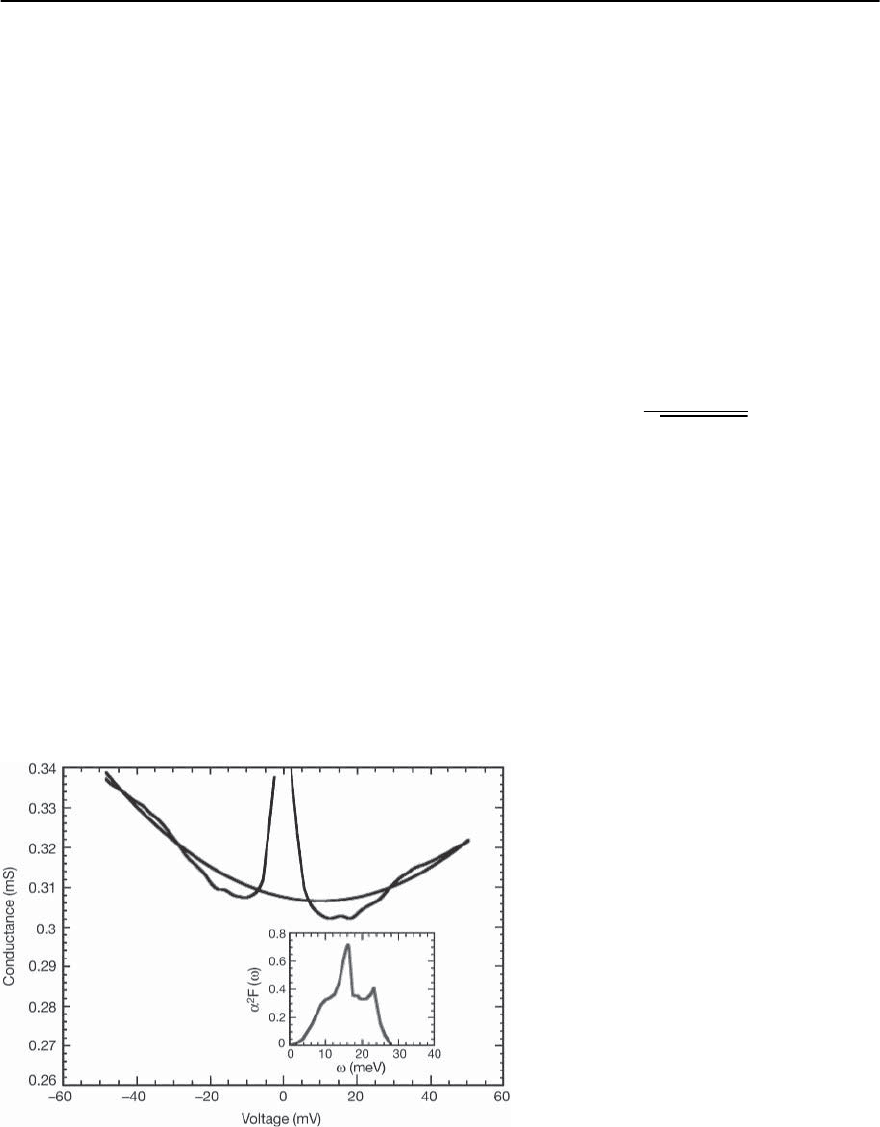
15 Tunneling Spectroscopy 839
such scattering events is the development of Andreev
boundstatesinthequasiparticleexcitationspectrum
at the Fermi energy. These bound states exist only at
the interface but nevertheless can have important ef-
fects on the measured tunneling spectrum, leading
to a zero bias conductance peak (ZBCP) in certain
geometries. These effects for d-wave superconduc-
tors were first discussed by C.R. Hu [15] and later
developed within a generalized BTK framework by
Tanaka and Kashiwaya [16].
Thed-waveBTK model is shown in Fig.15.6 where
the right panel indicates the geometry considered.
The angle ˛ is between the barrier normal and the
lobe direction of the d-wave order parameter. Con-
sider first the curves labeled A in the left panel of
Fig. 15.6 which correspond to Z =0.Thesecurves
represent the d-wave analogue of the Andreev re-
flection curve in Fig. 15.5 and display a less abrupt
decrease of the conductance near eV = compared
to the s-wavecasewhichisduetothegapnodes.
There is no ˛ dependence to the Z =0curvesbe-
cause all incident quasiparticles are assumed to have
equivalent transmission probabilities. The effect of
a tunnel barrier is seen in the curves labeled C. For
non-zero values of ˛ a sharp peak at zero bias is ob-
served and the coherence peaks at the gap voltage are
diminished considerably. Spectral weight in the DOS
has been shifted from the coherence peaks to the An-
dreev bound states which produce the ZBCP. There
is no ZBCP for c-axis tunnel junctions (Fig. 15.1(e))
because the barrier is parallel to the ab plane and
specular reflections off the interface have no effect
on in-plane wavevector and thus no sign change oc-
curs. It thus turns out that c-axis tunnel junctions
are the only ones capable of revealing the intrinsic
quasiparticle DOS.
15.2.5 Strong- Coupling Effects: Phonon Structure
For s-wave superconductors the extension of
Eq. (15.2) to the strong-coupling limit has been
worked out in Migdal–Eliashberg theory. [1] The su-
perconducting part of the DOS is given by
(E)=Re
|E|
E
2
−
2
(E)
, (15.5)
where now it is understood that (E)isacomplex
function of the quasiparticle energy, E, in the super-
conducting state. The imaginary part is related to the
finite lifetime of the quasiparticle due to emission of
phonons and thus becomes largest near peaks in the
phonon density of states. This gives rise to struc-
tures in (V) as shown in Fig. 15.7 for PCT junction
on single crystal Nb. [17] There are several notewor-
thy points to be made here. First, the normal state
conductance, often referred to as the background
conductance, is rather featureless, showing a weak,
Fig. 15.7. Tunneling conductance of Nb in the
superconducting andnormal states obtained by
PCT in the region of phonon structures, from
Huang et al. [17]. Peaks in ˛
2
F(!)(inset)give
rise to dip structures in the superconducting
state dynamic conductance

840 J.Zasadzinski
parabolic increase which is due to the barrier.Second,
the superconducting conductance near the phonon
structures is less than the normal state by about 1.5
percent. This leads to a dip in the normalized con-
ductance or superconducting DOS. Physically this
means that states have been lost in this region due to
phonon emission and have been transferred primar-
ily to lower energies leading to a pile-up at the gap
edge. This effect provides a straightforward means
of identifying strong coupling effects. Inversion of
the normalized conductance using the MR proce-
dure [1, 2], leads to ˛
2
F(!)shownintheinsetof
Fig. 15.7. The dip minima in (V) are close to the
peaks in ˛
2
F(!), but more precisely it is the maxima
of the second derivative,
d(V)
dV
,that correspond to the
peaks.
15.2.6 I nelastic Tunneling
Until now the only conductancechannel assumed for
the junction was elastic tunneling where initial and
final state energies are the same. However, transport
across a junction can occur by other means such as
inelastic tunneling [1,18],orresonanttunneling [19].
Resonant tunneling is a multistep process whereby
the electron first tunnels to a bound orbital state of
an impurity atom or ion in the tunnel barrier and
then tunnels again into the other electrode. This can
be elastic or inelastic and may involve more than one
intermediate steps. Resonant tunneling will not be
discussed since it tends to wash out the quasipar-
ticle DOS and the resulting spectra are indicative of
the barrier states.On the other hand, the spectra pre-
sentedhereare clearly associatedwiththe gap feature
in the DOS of the superconducting electrode since
they disappear above T
c
. However, the resonant tun-
neling process is believed to be playing an important
role in grain-boundary junctions on cuprates [20].
Of more relevance to the issues of concern here
is inelastic tunneling. With this channel it is as-
sumed that the electron undergoes either absorption
or emission of an excitation of energy ! simulta-
neously with tunneling through the barrier. At liq-
uid helium temperatures, the emission process dom-
inates,andthis occursata thresholdvoltage eV = !
when the tunneling electron has sufficient energy
to create the excitation. At this voltage the inelastic
conductance channel opens up and there is a step
increase in the conductance. For a flat continuum of
excitations the sum of such steps leads to a linear
increase in conductance [21].
Strong linear increases in background conduc-
tance were often seen in the early tunneling lit-
erature on cuprate and bismuthate superconduc-
tors [22]. An example of this effect is seen in
Fig. 15.8 for Pr
1.85
Th
0.85
CuO
4
which is similar to
the linear backgrounds observed in other electron
doped cuprates [23]. The V-shaped background ex-
hibits an increase in conductance of 100% or more
at 60 mV compared to the extrapolated value at
zero bias. This should be compared to the ordinary
parabolic shaped background for elastic tunneling
in Nb shown in Fig. 15.7. In that case the increase at
60 mV is only about 10% and is due to the barrier
effect from the Nb-oxide layer. For Al-Al oxide-Pb
junctions the increase would be about 2%. Thus it is
clear the strong V-shaped background is not a con-
sequence of ordinary barrier effects.
There was early speculation that the linear tunnel-
ingbackgroundmightbeintrinsicinoxidesupercon-
ductors,owingpossibly to the Marginal Fermi Liquid
Fig. 15.8. Measured conductances of three different
point contact tunnel junctions on a polycrystal of
Pr
1.85
Th
0.85
CuO
4
from the Argonne group (unpublished).
Similar strong linear increases are observed in other
electron-doped cuprates as seen in [23]

15 Tunneling Spectroscopy 841
behavior of the quasiparticle self-energy evident in
many experiments on optimal doped cuprates. How-
ever, such self-energy effects do not lead directly to
linear increases in the total electronic DOS, N(E),
abouttheFermienergy.Furthermore,Kirtleyshowed
that such an inelastic channel was easily induced in
ordinary tunnel barriers by introducing magnetic
impurities into the oxide [24]. The incoherent spin
fluctuationsof the weakly coupled spins gave the flat
continuum of excitations. Further evidence that the
linear background is due to an additional channel
can be found by considering the ratio of the con-
ductance peak height to background (PHB) which is
typically a value of 2 or more for high quality SIN
junctions (e.g. see Figs. 15.2 and 15.4). When strong
V-shaped backgrounds are observed the PHB ratio is
significantly smaller than 2 ascanbe seen in Fig.15.8.
This seems to be a general result.
15.3 Tunneling and Strong-Coupling Effects:
Microscopic Picture
Here we provide a more detailed theoretical treat-
ment of the tunneling process and examine the var-
ious approximations that go into the expression for
the tunnel current. We follow the transfer Hamilto-
nian approach of Bardeen [25]. The total Hamilto-
nian for the system is
H = H
l
+ H
r
+ H
T
, (15.6)
where H
l
and H
r
are the Hamiltonians for the left and
right metalsin theabsence of tunneling.Theperturb-
ing Hamiltonian H
T
for the weak virtual coupling is
given by
H
T
=
k,q
T
bfk,q
{c
†
q
c
k
+ c
†
k
c
q
}, (15.7)
where c
†
k
, c
k
, c
†
q
and c
q
are creation and annihila-
tion operators for quasiparticles in the eigen states
'
k
and '
q
of the left and right metals, respectively.
The tunneling matrix element
T
k,q
2
was obtained
by Harrison [26] as
T
k,q
2
=
L
4
2
ı
k
ı
q
k⊥
q⊥
exp[−2
z
r
z
l
K
⊥
(z)dz] , (15.8)
where
k
⊥
=(L/)dk
⊥
/d
⊥
is the one-dimensional
band structure density of states (proportional to the
inverse of the group velocity normal to the barrier)
and L is the length of the metal in the normal direc-
tion to the oxide surface. The group velocity nor-
mal to the barrier enters because the tunnel cur-
rent is a rate of charge transfer which necessarily
involves an attempt frequency of electrons on the
tunnel barrier. Here K
⊥
(z)=
2m['(z)−E
z
]/
2
,
E
z
= E −
2
(k
2
x
+ k
2
y
)/2m is the kinetic energy of the
electron in the z-direction (normal to interface), and
'(z) is the barrier potential.Here E is measured from
the bottom of the conduction band.
Due to the exponential dependence on the normal
component of energy, the tunneling matrix element
heavily weights the contributions of electrons nor-
mal to the barrier.There is also a voltage dependence
to the matrix element as the shape of the barrier
changes with V , e.g. an initially rectangular barrier
becomes trapezoidal with applied voltage.For values
of eV (z) this barrier effect is negligible and the
tunneling conductance for two normal metal elec-
trodes in nearly constant. However, as the applied
voltage becomes a reasonable fraction of the barrier
height, a parabolic term is added to the background
conductance, [27] an effect which can be observed in
Fig.15.7 since the barrierheight of Nb oxide is about
250 meV [17].
The standard Fermi’s Golden Rule for the tran-
sition rate !
r←l
from an initial state i on the left
metal to a final state f of equal energy on right metal
can be obtained by substituting Eq. (15.7) into the
time-dependent Schr¨odinger equation. Subtracting
the rate from right to left leads to the following form
for the tunnel current
I =2e
kq
|T
kq
|
2
∞
−∞
d!
2
A
R
(k, !)A
L
(q, ! + eV)
× [f (!)−f (! + eV)] .
This form for the tunnelcurrentisparticularly useful
for it incorporates the quasiparticle spectral weight
function
A(k, !)=
1
Im
Z! + "
k
Z
2
[!
2
− (k)
2
]−"
2
k
, (15.9)

842 J.Zasadzinski
a quantity that is measured directly in angle-resolved
photoemission spectroscopy (ARPES). The spectral
weight contains all information about electron cor-
relation effects via the renormalization parameter,
Z(k, E) and gap parameter, (k, E). The general
problem of a momentum dependent pairing inter-
action leading to a strong-coupled d-wave supercon-
ductor has not been solved self-consistently as with
Migdal–Eliashberg theory for s-wave superconduc-
tors. Consequently, calculations of A(k, !) usually
involvesometypeofapproximationscheme.The
connection to the quasiparticle DOS is given by
N(!)=
k
A(k, !) ,
which can be measured in tunneling. The simplest
case scenario is to assume the tunneling matrix el-
ement is a constant, independent of energy, voltage
and momentum, and can be taken out of the sum-
mation. Performing the sum over momenta leads
directly to Eq. (15.1), with N(!)correspondingto
the full, three dimensional quasiparticle DOS in-
cluding band structure and correlation effects. How-
ever,this scenario is unrealistic. The matrix element
of Eq. (15.8) is clearly not constant and heavily
weights quasiparticle momenta normal to the bar-
rier. If both electrodes are assumed to be nearly free
electron metals with ellipsoidal Fermi surfaces, then
the dominance of contributions to the tunnel cur-
rent from near-normal incident quasiparticles leads
to a collapse of the transverse momentum sum in
Eq. (15.9). The resulting momentum sum is over k
⊥
and q
⊥
which gives the one-dimensional band struc-
ture DOS and this is canceled exactly by the group
velocity term in the matrix element. For supercon-
ducting electrodes, the resulting expression is identi-
cal to Eq. (15.1),but with the superconducting DOS,
(E) used instead of N(E). This cancelation by the
group velocity, first pointed out by Harrison, leads to
the commonly held viewthat tunneling spectroscopy
does not probe band structure effects. However, this
is a consequence of several contributing factors, and
is not necessarily true in general.
Cuprate superconductors are composed of inco-
herently coupled Cu-O layers, giving rise to a quasi
two-dimensional system and Fermi surface. Even as-
suming some weak coherent coupling which would
give rise to dispersion along the c-direction, the re-
sulting Fermi surface would have open faces perpen-
dicular to the k
z
-direction. For STM or point con-
tact configurations where the tip is pointing along
the c-axis of cuprate superconductors there can be
no tunneling of electrons with momenta normal to
the barrier as there are no such states on the Fermi
surface. Thus it is expected that the tunneling cur-
rent from tip to sample in an STM junction or from
Cu-O plane to Cu-O plane in an intrinsic junction is
made up of electrons with momenta transverse to the
barrier.This is quite different from conventional su-
perconducting metals discussed earlier and the key
result is that there is no cancelation of band structure
effects from the group velocity normal to the barrier.
The resulting N(E) should be the 2D density of states
in the Cu-O plane including band structure effects.
Oneofthedominantfeaturesofthebandstruc-
ture is the extended saddle point near the (, 0) di-
rection which gives rise to a peak, or van Hove sin-
gularity (VHS), in the DOS [28]. Tunneling data out
to very high bias voltages has provided some evi-
dence for this feature as shown in Fig. 15.9 which is
an STM tunneling conductance on a cleaved surface
of Bi2212 [29]. In addition to an asymmetric back-
ground there appears to be a broad peak in the con-
ductance centered near zero bias. It is difficult to lo-
cate the VHS peak because the superconducting gap
feature (including dip structures) is emerging out of
this background. This broad peak has a width of at
least 800 meV which is consistent with the expected
bandwidth.
A similar broad peak is found in PCT conduc-
tances of Bi2212 measured by the Argonne tunneling
group (including some unpublished spectra, see, for
example, [30]). These are shown in Fig. 15.10 where
spectra from three different crystalswith slightly dif-
ferent oxygen dopings are presented. Again a broad
peak with a characteristic width of about 800 meV
can be inferred from the data. Yusof et al. have used
the fits of ARPES data to generate the band struc-
ture DOS for Bi2212 and this is shown in Fig. 15.11
for three different values of the quasiparticle scatter-
ing rate [31]. It is not clear what value of should
be used. Above T
c
the ARPES spectral weight peak
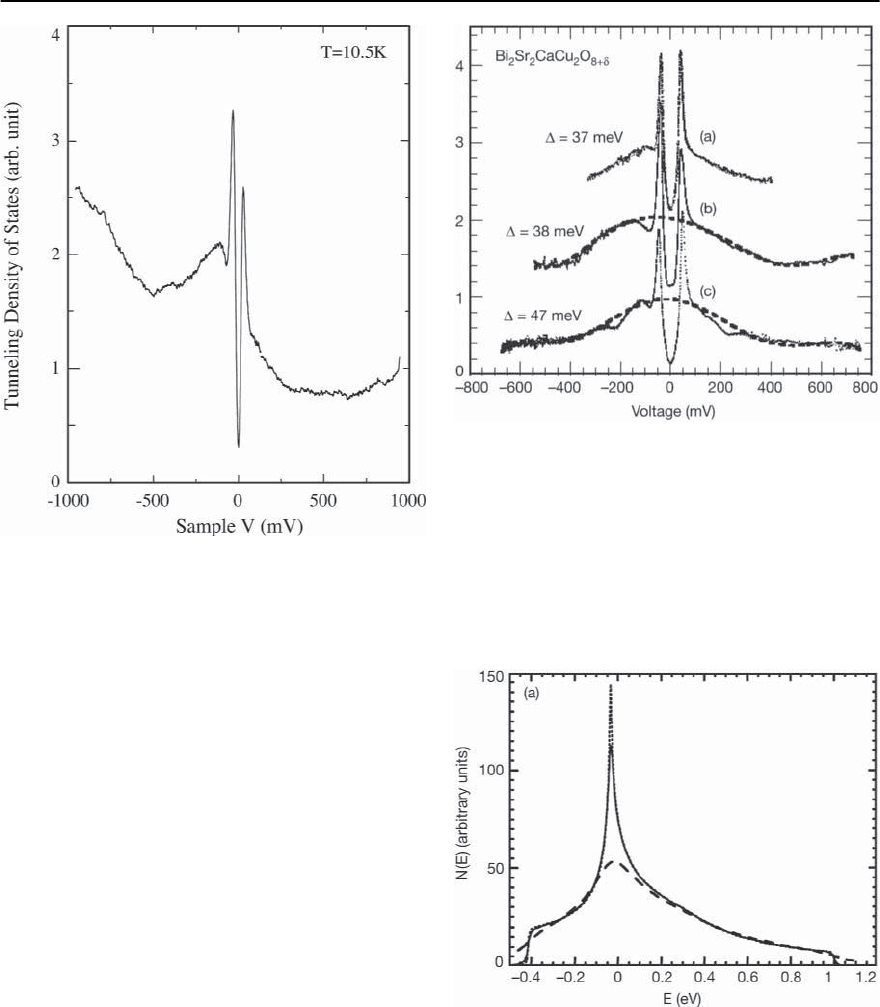
15 Tunneling Spectroscopy 843
Fig. 15.9. STM spectra of superconducting Bi2212 out to
high bias voltage. From Sugita et al. [29]
is considerably broadened, but is resolution limited
in the superconducting state. From observation of
Fig. 15.9 and Fig. 15.10 it appears that a value near
thesuperconducting gapenergy would provide a rea-
sonable fit to the measured high bias spectra.
Thus it appears that the decreasing background
conductance that is commonly observed in the tun-
neling conductances of hole-doped cuprates is due
to the underlying band structure DOS. However, the
VHS peak itself is never directly observed and this is
probably due to the fact that it is pinned somewhere
close to the Fermi energy and is thus inside the su-
perconducting gap. From the fits to the ARPES data
on near optimal doped Bi2212, the peak in the band
structure (b.s.) DOS is found about 30 meV below
the Fermi energy so this is consistent with such a fea-
ture getting masked when a superconducting gap of
= 35 meV develops in the superconducting state.
Above T
c
the scattering rate is increased consider-
ably and there might exist a pseudogap, both effects
tending to obscure the observation of the VHS.
Fig. 15.10. High bias PCT spectra of superconducting
Bi2212, obtained from three different crystals. (a) and (b)
correspond to optimally doped and (c) is from an under-
doped crystal. Dashed lines through (b) and (c) are sixth
order polynomial fits through the data
Fig. 15.11. Band structure density of states of Bi2212 as ob-
tained from fitting ARPES spectra, from [31]. The different
curves correspond to different values of the quasiparticle
scattering rate, .Thedotted, solid and dashed lines corre-
spond to =3,8,80meV,respectively

844 J.Zasadzinski
15.4 Tunneling Spectroscopy
of Conventional Superconductors
In the previous sectionthe basic formalism for elastic
tunneling was presented.For conventional supercon-
ductors with closed Fermi surfaces the tunnel cur-
rent in SIN junctionsis dominated by electrons with
momenta normal to the barrier. Consequently the
band structure DOS is canceled by the group veloc-
ity and only the superconducting part, (E), rescaled
by a constant enters Eq. (15.2). This technical point
is generally ignored for conventional superconduc-
tors, but as was shown in the previous section the
role of band structure effects can be quite important
for understanding the tunneling spectra of cuprate
superconductors.
Since most conventional superconductors, espe-
cially s-p metals and alloys, have a weak energy de-
pendence of the b.s.DOS near the Fermi energy,then
even if the N(E) was the full DOS, the band struc-
ture part would be expected to be nearly constant
over the voltage range of interest (approximately 50
meV). Normalization of the tunneling data would be
expected to give (E) as before, giving an implicit
measure of (E) via Eq. (15.5). An example of such
data for ZrN,and the corresponding analysis,is given
below.
Before proceeding it is reasonable to ask whether
there is any evidence that the tunnel current in con-
ventional superconductors is dominated by electrons
normal to the barrier. Noteworthy here is the fact
that planar junctions on single crystals of Nb ex-
hibit reproducibly different ˛
2
F(!) for junctions
fabricated on (100),(110) and (111) crystallographic
planes. This is perhaps the most direct evidence for
tunneling directionality effects [1]. Also, junctions
on (N/S) bilayers are consistent with proximity effect
models which assume specular tunneling normal to
the barrier. This is discussed later.
15.4.1 McMillan–Rowell Analysis
Thereisanexhaustiveliteratureonconventional,
lower T
c
superconductors,detailing how the complex
gap parameter, (E), can be inverted using Migdal–
Eliashberg theory [1] to obtain the microscopic inter-
actions responsible for superconductivity. The pro-
cedure of McMillan and Rowell (MR) [2] is iterative,
beginning with an educated guess for the electron–
phonon spectral function,˛
2
F(!)andtherenormal-
ized coulombpseudopotential,
∗
.These parameters
arethenrefined by comparisonof the calculated (E)
with the measured normalized conductance. We will
not review the early works but rather show some
relatively recent data on the binary compound, ZrN,
which has a T
c
of 9.4 K and is exemplary of the MR
analysis [32].This material is also of interest because
it exhibits relatively high frequency optical phonon
modes and the issues concerning whether and how
electrons couple to such modes is of great interest.
ZrN is one member of a class of transition metal com-
pounds with the NaCl structure such as NbN, NbC,
and HfN. These materials have excellent mechani-
cal properties as well as superconducting transition
temperatures as high as 18 K.
Thin films of ZrN were prepared by reactive sput-
tering and then oxidized in laboratory air for 50
h to form the tunnel barrier. The planar junction
was completed by evaporation of an In counterelec-
trode. In Fig. 15.12 is shown the dynamic conduc-
tance
dI
dV
vs. V in the superconducting and normal
state.Acoustic mode phonon structuresare observed
in the range 20-30 mV and a distinct dip feature is
found near 60 mV which is in the range of opti-
cal phonons. Note that these phonon structures in
the superconducting state conductance lie below the
normal state curve and this is a critical feature of
strong coupling effects, arising from the imaginary
part of the gap function (E) and reflecting a loss of
states in this region. Had this feature been due to an
inelastic channel opening up there would be an in-
crease of conductance in both the superconducting
and normal state spectrum.
In Fig. 15.13 is shown the reduced conductance
(
(V)
BCS
-1) and the fit obtained from the MR inversion
analysis. Also shown is the resulting ˛
2
F(!)spec-
trum which is found to be in very good agreement
with the phonon density of states F(!)measured
by inelastic neutron scattering. The coulomb pseu-
dopotential
∗
= 0.1 is in the expected range and
the calculated T
c
=8.4 K is reasonably close to the
experimental value. This experiment provides clear-
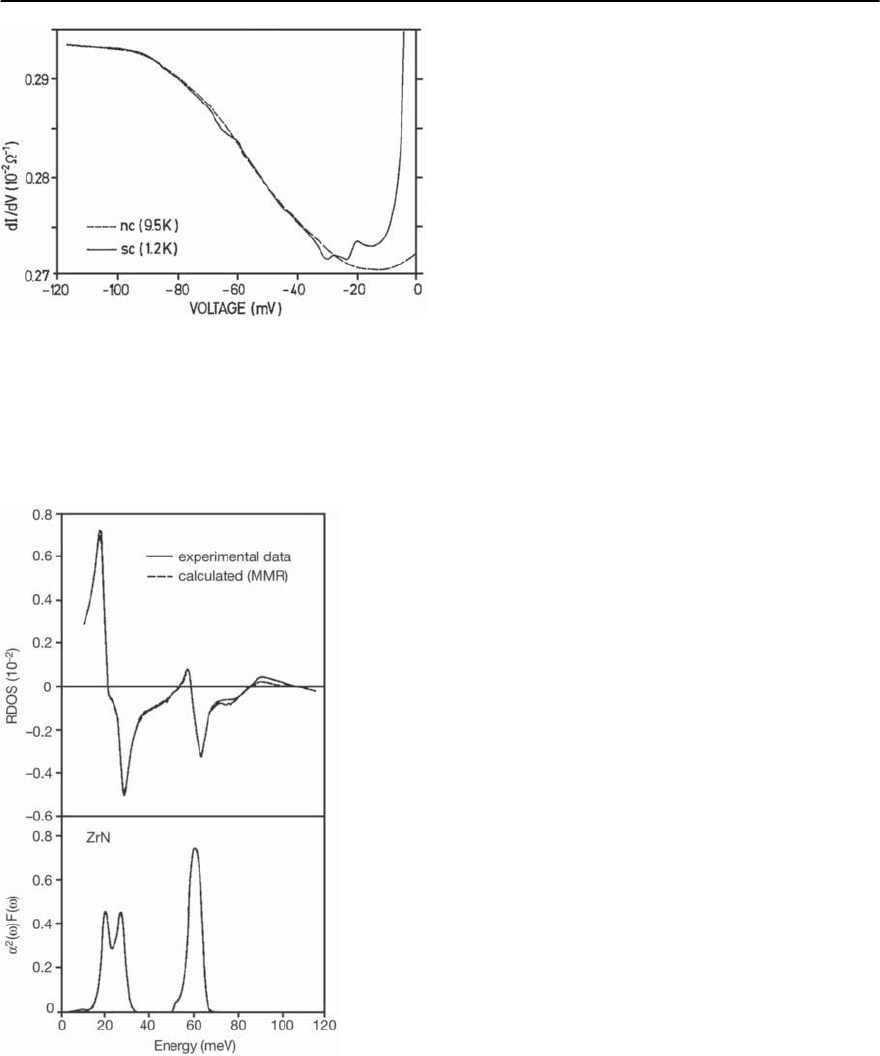
15 Tunneling Spectroscopy 845
Fig. 15.12. Superconducting (solid line) and normal state
(dashed line) conductance for planar junction, ZrN/ZrN-
oxide/In. The superconductivity of In has been quenched
with a small magnetic field
Fig. 15.13.Top p anel : measured and calculated reduced con-
ductance. Bottom panel: the resulting ˛
2
F(!)fromMR
inversion
cut evidence for electron coupling to high frequency
optical modes. It is for this reason that such a rela-
tively high-T
c
couldbeobtainedwitharathermod-
erate coupling strength =0.62. It is thus clear that
for oxide superconductors, which have even higher
frequency optical phonon modes,the possible role of
electron–phonon coupling must be considered.
15.4.2 Proximity Effect Tunneling in Conventional
Superconductors
Tunneling investigations of (N/S) bilayers has had
a tremendous impact on the field of conventional
superconductivity from both a fundamental and ap-
plied perspective.Such studies have provided a more
complete understanding of the electron–phonon in-
teraction (even in non-superconducting elements
such as Mg) and have generated numerous electronic
devices, such as high-speed A/D converters and sen-
sitive photon detectors. A brief discussion of this
area is therefore warranted. Furthermore, the field
is mature and well understood so that speculations
about proximity effects in unconventional supercon-
ductors such as high-T
c
cuprates can be critically
examined using this information base.
We imagine here junctions of the form C-I-NS
where C is a convenient counterelectrode, either a
normal metal forspectroscopy studies of the N and S
layer, or a superconductor for studies of the Joseph-
son effect and related device phenomena. Thus tun-
neling is into (or out of) the N side of the normal
metal/superconductor sandwich as shown schemat-
ically in the inset of Fig. 15.14. By using N lay-
ers of known thickness and properties, such struc-
tures have extended the standard tunneling spec-
troscopy and MR inversion procedure to include
superconducting elements, alloys and compounds
which themselves do not form suitable surface ox-
ides for tunnel barriers or which are strongly affected
by proximity to non-native oxides, such as from the
counterelectrode [1,33].
Simple examples are Nb and V whose native sur-
face oxides are complex, consisting of various oxide
phases (including e.g. NbO which is metallic). These
complex oxides also have defects, e.g. voids or ion-
ized atoms, which increase the likelihood of mul-
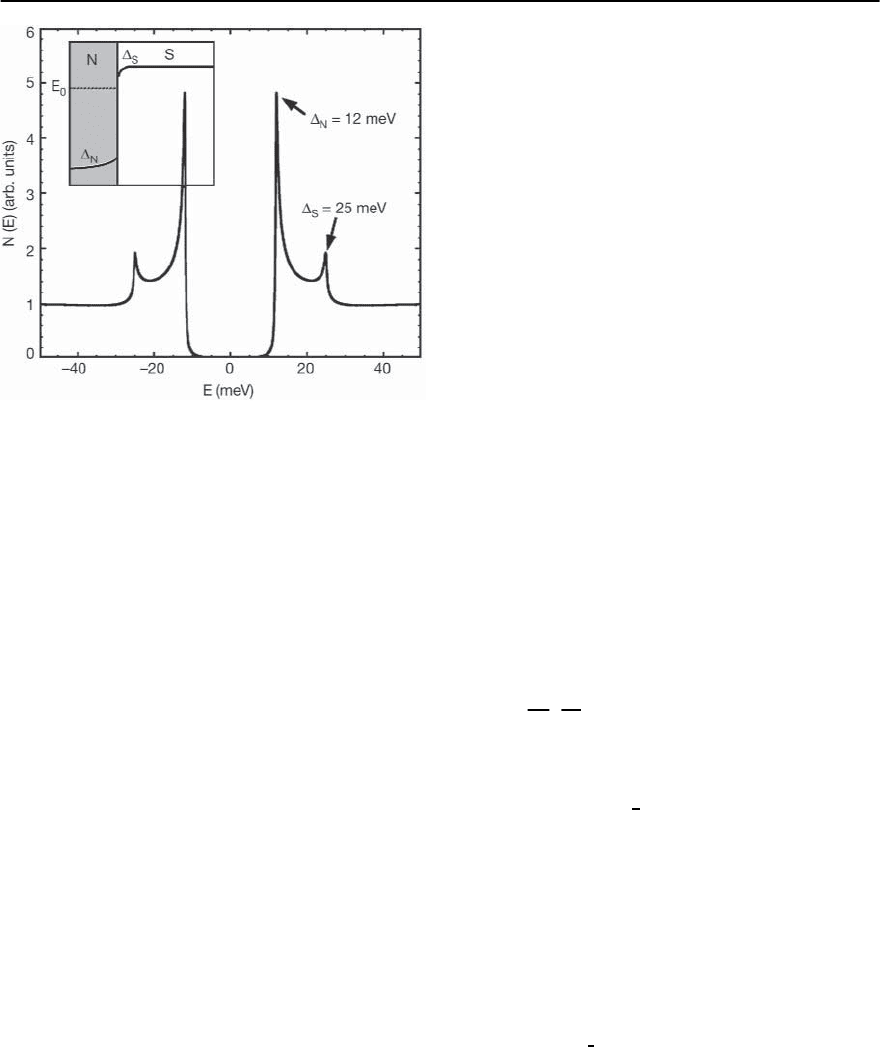
846 J.Zasadzinski
Fig. 15.14. McMillan model for the density of states N
N
(E)
obtained for tunneling into the N side of an NS bilayer.In-
set: schematic representation of the superconducting gap
parameters in the proximity sandwich
tistep, resonant tunneling processes which compete
with the desired direct elastic tunneling between the
two metal electrodes. [34] In addition, even small
amounts of diffused oxygen are known to rapidly
decrease the superconducting T
c
of Nb and V (ap-
proximately 1 K per atomic percent of oxygen) which
means the standard fabrication method of evaporat-
ing or sputtering Nb or V onto oxidized films of Al
does not work. The resulting gap region characteris-
tics are extremely broadened and all phonon struc-
tures are smeared out, most likely due to the fact that
the resulting junction is of the form Al/Al-oxide/S’S
where S’ is an inhomogeneous, disordered layer of
reduced superconductivityon the surface of the bulk
superconductor of interest.
To circumvent such problems, a new method was
developed during the mid 1970sknown as proximity
electron tunneling spectroscopy (PETS) [35], which
allowed a quantitative fit to the tunneling spectra
of N/S bilayers using the proximity effect theory of
Arnold.The two relevant models for proximity effect
tunneling are those of McMillan and Arnold which
we discuss briefly. The McMillan model assumes the
N/S interface has a weak, delta function barrier for
diffuse tunneling to occur, allowing a perturbation
treatment of the problem. The calculation generates
a set of coupled non-linear equations which deter-
mine the gap functions,
S
(E) in the S layer (reduced
from itsbulk value) and
N
(E) induced in the normal
layer.The quasiparticle density of states in each layer
is that given by Eq. (15.5) but with the appropriate
gap parameter.Assuming the N layer has no intrinsic
pairing interaction and is much thinner than S, then
the McMillan DOS in the N layer is determined by
two parameters, the bulk superconducting gap and a
scattering rate,
N
, which is inversely proportional to
the N layer thickness.
An example of the expected tunneling density of
states in the normal metal from the McMillan model
is shown in Fig. 15.14 assuming a superconductor
with a bulk gap of 25 meV, a value typical for high-T
c
cuprates.While the McMillan model has intuitiveap-
peal for understanding the proximity effect attempts
to extract ˛
2
F(!) in either the N or S layer were un-
successful [33].The PETS method utilizes a clean N/S
interface and this is described by the Arnold model,
which, in the limit of small N-layer thickness, allows
a direct measure of the underlying S-layer gap func-
tion [33]. The specular N/S interface also results in
resonance effects due to Andreev reflection, and this
leads to quasiparticle bound states in the N layer as
well as higher energy oscillations of the DOS. The
relevant parameter which determines these effects
is R =(
1+r
1−r
)
2d
hv
f
.Herer is the reflection coefficient
between N and S layers due to differences in Fermi
momenta,v
f
is the fermi velocityin the N layer and d
is the N-layer thickness. The first bound state energy
is given by,E
0
=
S
(1−
1
2
(R
2
S
),and is shown schemat-
ically in Fig. 15.14. An example of the DOS for very
thick N layers is shown in Fig.15.15 where the bound
states and oscillations are clearly visible.
Of more relevance to the issue of pairing interac-
tions is the Arnold model in the ultra thin N layer
limit, i.e. R ≈ 0. In this case it can be shown that
phonon structures from the underlying S layer as
embedded in
S
(E) can be observed as if tunneling
directly into S, but with a reduced amplitude scaled
by the factor e
−
d
l
. Thus the standard MR inversion
procedure can be used but modified to include an
additional free parameter, d/l,wherel is a quasipar-
ticle mean-free-path in the N layer. This is referred
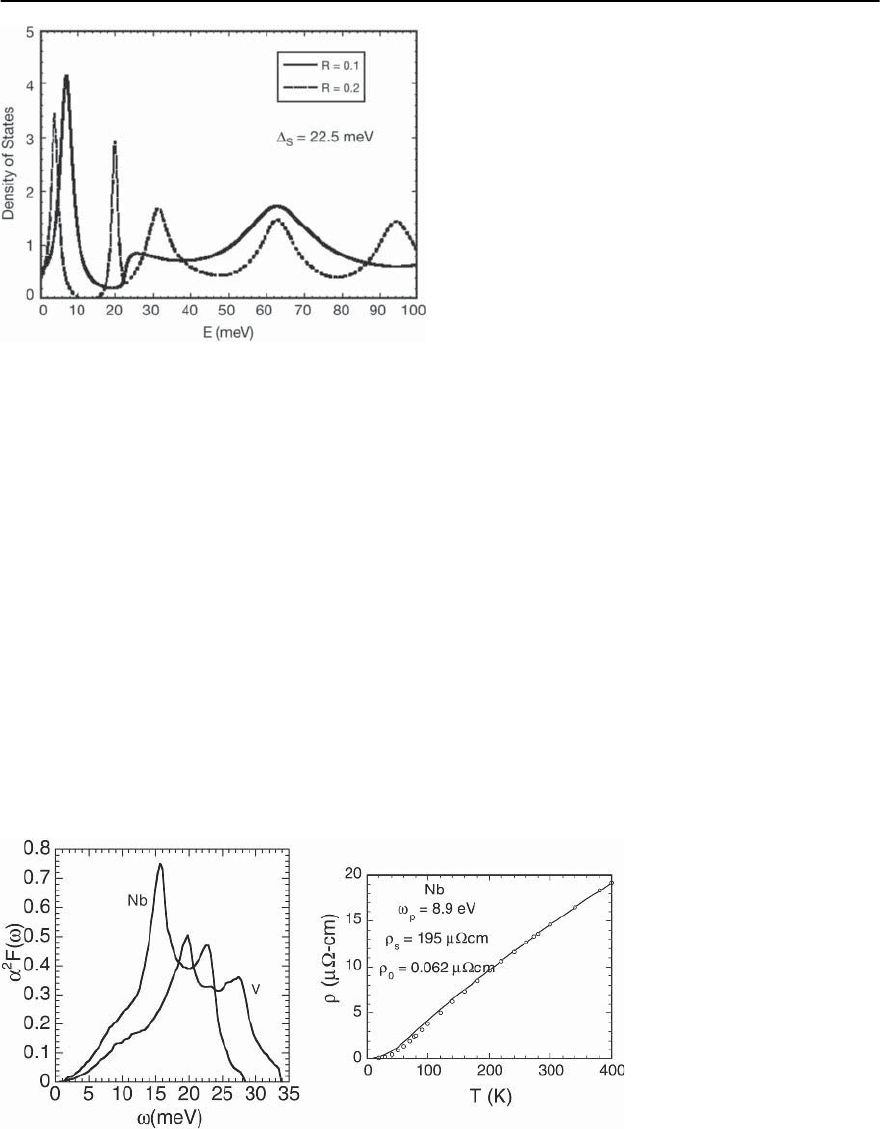
15 Tunneling Spectroscopy 847
Fig. 15.15. Arnold density of states for relatively large R
values. Note the presence of two bound states for R =0.2
to as the modified McMillan–Rowell or MMR proce-
dure.
From the experimental side the idea was to form a
nearly perfect N/Sinterface by depositing a thin layer
of Al onto a clean single crystal superconductor, such
as Nb, in an ultra-high vacuum environment. The Al
layer was known to provide an ideal, self-limiting
oxide tunnel barrier and at the same time the unoxi-
dizedportionwouldprovideaprotectivelayerforthe
superconductor.The first successful junctions of this
type on Nb and V showing clear phonon structures
were published in 1978 [35] and a full quantitative
analysis using theArnold proximity effect model ap-
peared a few years later [36,37].These results showed
that the standard MR inversion procedure could be
extended to (N/S) bilayers allowing a determination
of ˛
2
F(!) in transitionmetals such as Nb andV. Ex-
amples of these spectra using the PETS method are
shown in Fig. 15.16. These and other ˛
2
F(!)spectra
have been used successfully to determine the phonon
contributionto the temperature dependent electrical
resistivity above T
c
in several superconducting ele-
ments and compounds. An example of the fit of Nb
data is shown in the right panel of Fig. 15.16 taken
from the work of Tralshawala et al. [5]. The PETS
method has been used to examine alloys such as
NbZr as well as A-15 compounds such as Nb
3
Sn [1].
After the discovery that a thin Al overlayer could
provide a pinhole free oxide barrier on Nb, the prox-
imity effect method was extended to SIS junctions of
thetypeNb/Al/Al-oxide/Nbwhereitwasshownthat
excellent Josephson tunnel junctions could be ob-
tained.Further development of this method included
the patterning of arrays of such junctions which are
now the basis for all superconducting electronic de-
vices [38].
15.5 Tunneling in High-Temperature
Superconductors
Since the discovery of high temperature supercon-
ductivity in layered copper oxides by Bednorz and
M¨uller [39] in 1986 there has been a worldwide effort
to obtain tunnel junctions on these materials. Many
of the early efforts suffered from complications ow-
ing to the ceramic nature of cuprates and the fact
that the superconductivity exists only over a narrow
Fig. 15.16. Left: ˛
2
F(!)forNb
andV obtained from N/S prox-
imity bilayers using Al overlay-
ers. Right:thefittoNbresistiv-
ity using the electron–phonon
spectral function, from Tral-
shawala et al. [5]
